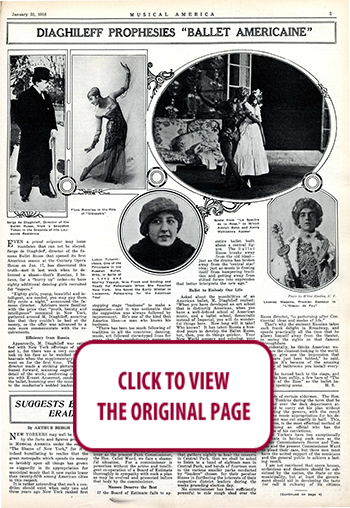 100 YEARS AGO IN MUSICAL AMERICA (127)
100 YEARS AGO IN MUSICAL AMERICA (127)
January 22, 1916
Page 3
DIAGHILEFF PROPHESIES “BALLET AMERICAINE”
EVEN a grand seigneur may issue mandates that cannot be obeyed. Serge de Diaghileff, director of the famous Ballet Russe that opened its first American season at the Century Opera House on Jan. 17, has discovered this truth—met it last week when he delivered a ukase—that’s Russian, I believe, for a “hurry up” order—to have eighty additional dancing girls recruited for “supers.”
“Eighty girls, young, beautiful and intelligent, are needed, you may pay them fifty cents a night,” announced the famous director. Advisers more familiar with the price that “youth, beauty and intelligence” command in New York, gathered around M. Diaghileff, assuring him that they couldn’t be had at the money, so the offer was advanced to a rate more commensurate with the requirements.
Efficiency from Russia
Apparently, M. Diaghileff was satisfied with New York offerings of y., b. and i., for there was a very contented look on his face as he watched the rehearsals when the supplementary chorus went on for the first time. The great director made a striking picture as he leaned forward, scanning eagerly every detail of the work; conferring one minute with Ernest Ansermet, conductor of the ballet, humming over the music softly to the conductor’s nodded leadership, or stopping stage “business” to make a suggestion—and it was noticeable that the suggestion was always followed by improvement. He’s one of the kind that America likes—a man who knows his business.
“There has been too much following of tradition in all the countries; dancing, music, art followed stereotyped lines for years, then the revolutionary movement came—and with it the Ballet Russe,” said he, when questioned regarding the movement of which the Ballet Russe is the visible result.
“Why did it develop in Russia? Merely the psychological moment. Russia had evolved a wonderful school of artists, of dancers, of music; these we combined in a great ensemble. We gathered the talent of every school and created for it a new field of expression. Formerly you have seen the Russian stars, with the entire ballet built about a central figure. The Ballet Russe breaks away from the old ideal—just as the drama has broken away from the ‘central star’ idea; just as music is freeing itself from hampering tradition and getting away from stilted forms into expression that better interprets the new age.”
Ballet to Embody Our Life
Asked about the possibilities of an American ballet, M. Diaghileff replied: “When you have developed an art school that is distinctly American, when you have a well-defined school of American music, and a ballet school, democratic instead of Imperial, you will do wonderful things here. How long will it take? Who knows? It has taken Russia a hundred years to develop the Ballet Russe, but, then, you do things quicker. Your New World scenery and coloring, your busy, rushing life, your spontaneity and enthusiasm—these your artists will gather together—are gathering now—and you will, some time, have a ballet that will embody them all.”
Endorses American Hotels
M. Diaghileff likes American hotels, “they are so typical of your people,” he says. “The obvious mistake America makes, and that seems to be only by a very small number,” declares the Ballet Russe director, “is patterning after Continental ideas and modes of life.”
That’s why the eminent Russian takes such frank delight in Broadway, and spends practically all the time that he allows himself away from the theater, in seeing the sights on that famous thoroughfare.
Incidentally, he thinks American women are the cleanest-looking in the world.
“They give one the impression that they have just been tubbed,” he said, “perhaps it’s because of the amazing number of bathrooms you install everywhere.”
And he turned back to the stage, and began to hum softly, a few bars of “The Specter of the Rose” as the ballet began its opening scene. —M. S.




 RENT A PHOTO
RENT A PHOTO





